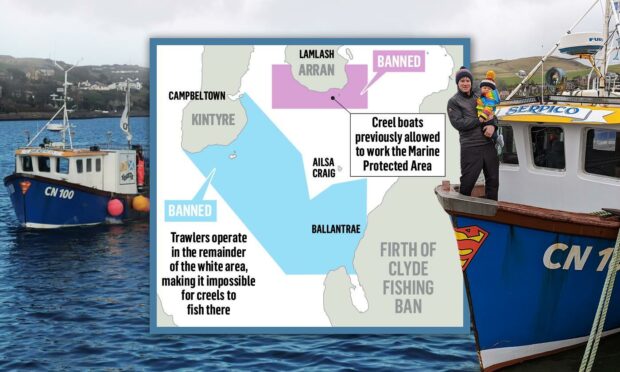A skipper on a tiny creel boat faces losing his family business due to an “unfair” fishing ban designed to protect cod stocks.
The Scottish Government has banned fishing in a large area of the Clyde between Kintyre and South Ayrshire for 11 weeks, and it appears the smallest boats will suffer the most.
Campbeltown skipper Paul McAllister, 32, is the owner of Serpico, a 33ft boat which uses a selective method to fish for prawns.
He has two crew members.
Mr McAllister has fished sustainably in the marine protected area (MPA) south of Arran for six years.
Creel fishermen are normally allowed to work the protected area because the method of catching does not damage the seabed.
The prawns swim inside the creel pots, whereas trawlers drag nets along the seabed.
However, all boats have been included in the ban, which was introduced on February 14.
The area affected includes the stretch of sea between Campbeltown and Ballantrae and the box south of Arran.
The Clyde Fishermen’s Association successfully campaigned to have part of the banned area, situated between the Mull of Kintyre Lighthouse and Stranraer, reduced.
This means that there is some ground left in the Clyde where trawlers can fish – but creel boats are unable to work there, as they would risk having gear towed away by the trawlers.
Mr McAllister, a father of one, said: “Three creel boats are affected. We can’t go anywhere else.
“I will need to use all my savings to survive. I have got a loan on the boat. I have still got all these expenses.
‘There was no consultation’
“I genuinely feel so let down by the powers that be.
“There was no consultation, and there is no science behind it.
He said that going by last year’s prices, he will lose out on £35,000 during the ban.
Mr McAllister said: “It blows my mind that it can be legal for a government to simply tell me I cannot go to work.
“There has been no mention from the Scottish Government of any compensation for loss of earnings during the ban – the people making these decisions seem to have forgotten that it affects small business and real families in rural communities.
“Currently, in the best case scenario I will lose 25% of the year’s earnings for my business and for my crew.”
No financial assistance
Kenny Campbell, 47, skipper of the 32ft Soph Ash, a crab creeler which works out of Campbeltown, said: “I have got no income until the start of May. I’m getting no financial assistance.
“We creel fishermen feel we have been singled out. I have been fishing here for 30 years and I have never landed a cod in my life.
“It is crazy to blame three creel boats for disturbing spawning cod.”
Alistair Bally Philip, national coordinator of the Scottish Creel Fishermen’s Federation, called for creelers and divers to be exempt from the closure area, or be subject to separate management measures.
‘Severely impacted’
He said: “We would again highlight the fact that, unlike trawling and dredging, creel vessels can not simply move elsewhere.
“Those creel vessels whom are likely to be most severely impacted should be offered financial support.”
But the Scottish Government is standing firm.
A spokesman said: “The revised closure areas are a pragmatic and evidence-based solution to ensure that primarily, we are still seeking to protect the spawning cod whilst also mitigating potential socio-economic impacts on our vulnerable coastal communities.
“Whilst we fully understand that removal of the exemptions may come with short-term costs, this seasonal closure covers a short period of 11 weeks, during which vessels may fish in alternative locations, which the vast majority regularly do.”


